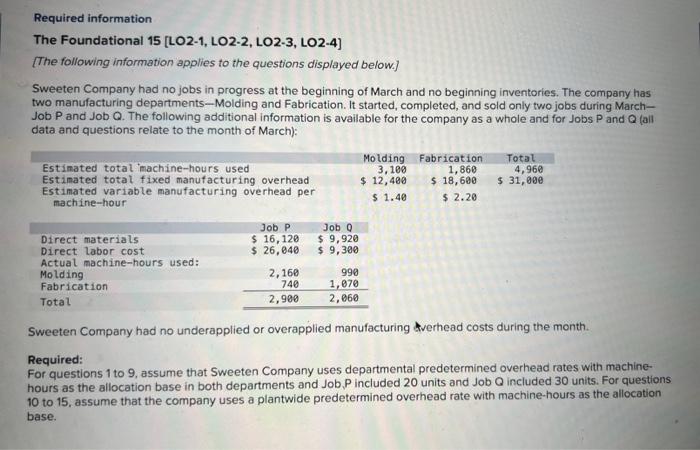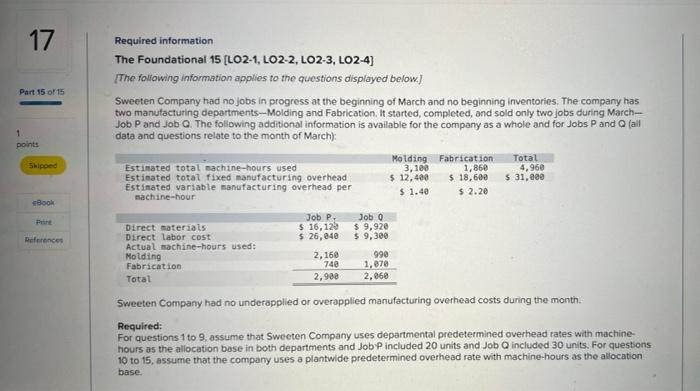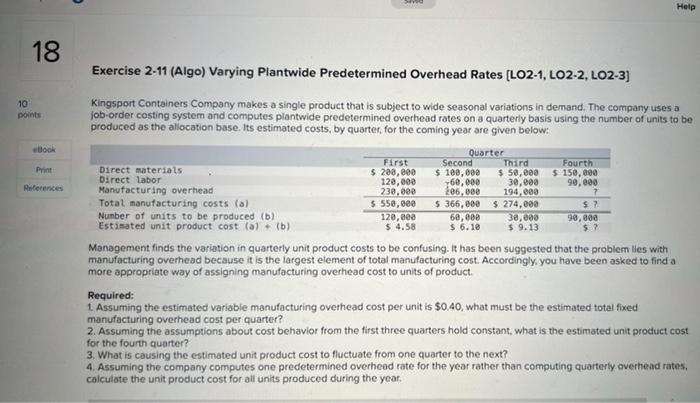Answered step by step
Verified Expert Solution
Question
1 Approved Answer
please solve these questions step by step. i keep getting them wrong. #1 #2 #3 Required information The Foundational 15 [LO2-1, LO2-2, LO2-3, LO2-4] [The
please solve these questions step by step. i keep getting them wrong. 





Required information The Foundational 15 [LO2-1, LO2-2, LO2-3, LO2-4] [The following information applies to the questions displayed below.] Sweeten Company had no jobs in progress at the beginning of March and no beginning inventories. The company has two manufacturing departments - Molding and Fabrication. It started, completed, and sold only two jobs during MarchJob P and Job Q. The following additional information is available for the company as a whole and for Jobs P and Q (all data and questions relate to the month of March): Sweeten Company had no underapplied or overapplied manufacturing twerhead costs during the month. Required: For questions 1 to 9, assume that Sweeten Company uses departmental predetermined overhead rates with machinehours as the allocation base in both departments and Job,P included 20 units and Job Q included 30 units. For questions 10 to 15 , assume that the company uses a plantwide predetermined overhead rate with machine-hours as the allocation base. 12. If Job P included 20 units, what was its unit product cost? (Do not round intermediate calculations. Round your final answer to nearest whole dollar.) Required information The Foundational 15 [LO2-1, LO2-2, LO2-3, LO2-4] [The foliowing information applios to the questions displayed below] Sweeten Company had no jobs in progress at the beginning of March and no beginning inventories. The company has two manufacturing departments-Molding and Fabrication, It started, completed, and sold only two jobs duning MarchJob P and Job Q. The following additional information is available for the company as a whole and for Jobs P and Q (ail data and questions relate to the month of March): Sweeten Company had no underapplied or overapplied manufacturing overhead costs during the month. Required: For questions 1 to 9 , assume that Sweeten Company uses departmental predetermined overhead rates with machinehours as the allocation base in both departments and Job P included 20 units and Job Q included 30 units. For questions 10 to 15 , assume that the company uses a plantwide predetermined overhead rate with machine-hours as the allocation base. 15. What was Sweeten Company's cost of goods sold for March? (Do not round intermediate calculations.) Exercise 2-11 (Algo) Varying Plantwide Predetermined Overhead Rates [LO2-1, LO2-2, LO2-3] Kingsport Containers Company makes a single product that is subject to wide seasonal variations in demand. The company uses a job-order costing system and computes plantwide predetermined overhead rates on a quarterly basis using the number af units to be produced as the allocation base. Its estimated costs, by quarter, for the coming year are given below: Management finds the variation in quarterly unit product costs to be confusing. it has been suggested that the problem lies with manufacturing overhead because it is the largest element of total manufacturing cost. Accordingly, you have been asked to find a more appropriate way of assigning manufacturing overhead cost to units of product. Required: 1. Assuming the estimated variable manufacturing overhead cost per unit is $0.40, what must be the estimated total fixed manufacturing overhead cost per quarter? 2. Assuming the assumptions about cost behavior from the first three quarters hold constant, what is the estimated unit product cost for the fourth quarter? 3. What is causing the estimated unit product cost to fluctuate from one quarter to the next? 4. Assuming the company computes one predetermined overheed rate for the year rather than computing quarterly overhead rates, calculate the unit product cost for all units produced during the year. Assuming the company computes one predetermined overhead rate for the year rather than computing quarterly overhead rates, calculate the unit product cost for all units produced during the year. Note: Do not round intermediate calculations and round your final answer to 2 decimal places #1


#2


#3


Step by Step Solution
There are 3 Steps involved in it
Step: 1

Get Instant Access to Expert-Tailored Solutions
See step-by-step solutions with expert insights and AI powered tools for academic success
Step: 2

Step: 3

Ace Your Homework with AI
Get the answers you need in no time with our AI-driven, step-by-step assistance
Get Started


